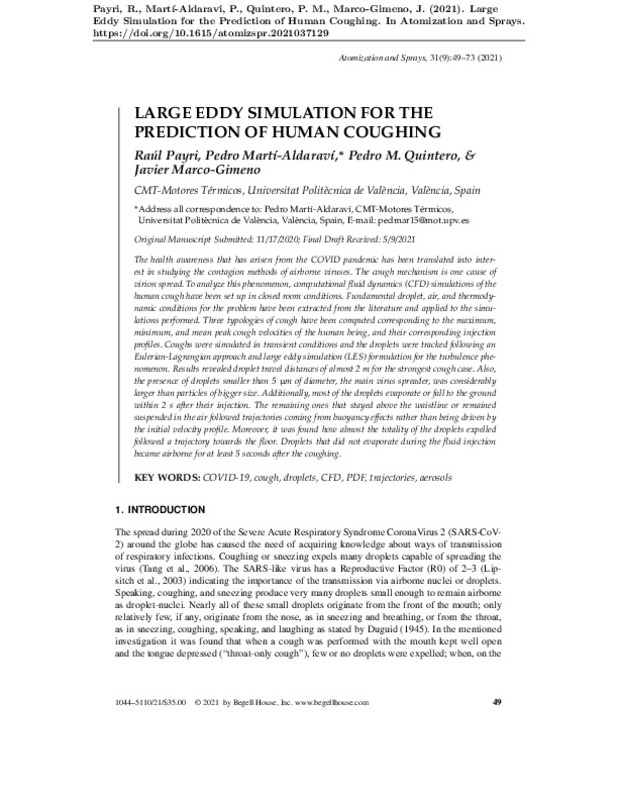JavaScript is disabled for your browser. Some features of this site may not work without it.
Buscar en RiuNet
Listar
Mi cuenta
Estadísticas
Ayuda RiuNet
Admin. UPV
LARGE EDDY SIMULATION FOR THE PREDICTION OF HUMAN COUGHING
Mostrar el registro sencillo del ítem
Ficheros en el ítem
| dc.contributor.author | Payri, Raul
|
es_ES |
| dc.contributor.author | Marti-Aldaravi, Pedro
|
es_ES |
| dc.contributor.author | Quintero-Igeño, Pedro-Manuel
|
es_ES |
| dc.contributor.author | Marco-Gimeno, Javier
|
es_ES |
| dc.date.accessioned | 2022-06-08T18:05:57Z | |
| dc.date.available | 2022-06-08T18:05:57Z | |
| dc.date.issued | 2021 | es_ES |
| dc.identifier.issn | 1044-5110 | es_ES |
| dc.identifier.uri | http://hdl.handle.net/10251/183127 | |
| dc.description.abstract | [EN] The health awareness that has arisen from the COVID pandemic has been translated into interest in studying the contagion methods of airborne viruses. The cough mechanism is one cause of virion spread. To analyze this phenomenon, computational fluid dynamics (CFD) simulations of the human cough have been set up in closed room conditions. Fundamental droplet, air, and thermodynamic conditions for the problem have been extracted from the literature and applied to the simulations performed. Three typologies of cough have been computed corresponding to the maximum, minimum, and mean peak cough velocities of the human being, and their corresponding injection profiles. Coughs were simulated in transient conditions and the droplets were tracked following an Eulerian-Lagrangian approach and large eddy simulation (LES) formulation for the turbulence phenomenon. Results revealed droplet travel distances of almost 2 m for the strongest cough case. Also, the presence of droplets smaller than 5 ¿m of diameter, the main virus spreader, was considerably larger than particles of bigger size. Additionally, most of the droplets evaporate or fall to the ground within 2 s after their injection. The remaining ones that stayed above the waistline or remained suspended in the air followed trajectories coming from buoyancy effects rather than being driven by the initial velocity profile. Moreover, it was found how almost the totality of the droplets expelled followed a trajectory towards the floor. Droplets that did not evaporate during the fluid injection became airborne for at least 5 seconds after the coughing | es_ES |
| dc.description.sponsorship | The equipment and resources used in this work have been partially supported by "Conselleria d'Educacio, Investigacio, Cultura y Esport" of Generalitat Valenciana in the framework of the "Ajudes per a grups d'investigacioconsolidables" program (Project Reference AICO/2020/208) . Additionally, the Ph.D. student Javier Marco-Gimeno has been funded by a grant from the Gov-ernment of Generalitat Valenciana with reference ACIF/2020/259 and financial support from The European Union. | es_ES |
| dc.language | Inglés | es_ES |
| dc.publisher | Begell House Inc. | es_ES |
| dc.relation.ispartof | Atomization and Sprays | es_ES |
| dc.rights | Reserva de todos los derechos | es_ES |
| dc.subject | COVID-19 | es_ES |
| dc.subject | Cough | es_ES |
| dc.subject | Droplets | es_ES |
| dc.subject | CFD | es_ES |
| dc.subject | es_ES | |
| dc.subject | Trajectories | es_ES |
| dc.subject | Aerosols | es_ES |
| dc.subject.classification | INGENIERIA AEROESPACIAL | es_ES |
| dc.subject.classification | MAQUINAS Y MOTORES TERMICOS | es_ES |
| dc.title | LARGE EDDY SIMULATION FOR THE PREDICTION OF HUMAN COUGHING | es_ES |
| dc.type | Artículo | es_ES |
| dc.identifier.doi | 10.1615/AtomizSpr.2021037129 | es_ES |
| dc.relation.projectID | info:eu-repo/grantAgreement/GENERALITAT VALENCIANA//ACIF%2F2020%2F259//AYUDA PREDOCTORAL GVA-MARCO GIMENO. PROYECTO: ESTUDIO COMPUTACIONAL DE LA FORMACION Y EL DESARROLLO DE CHORROS LIQUIDOS EN CONDICIONES DE BAJA PRESION/ | es_ES |
| dc.relation.projectID | info:eu-repo/grantAgreement/GENERALITAT VALENCIANA//AICO%2F2020%2F208//NUEVOS CONCEPTOS EN INYECCIÓN DE GASOLINA (NCIG)/ | es_ES |
| dc.rights.accessRights | Abierto | es_ES |
| dc.contributor.affiliation | Universitat Politècnica de València. Departamento de Máquinas y Motores Térmicos - Departament de Màquines i Motors Tèrmics | es_ES |
| dc.description.bibliographicCitation | Payri, R.; Marti-Aldaravi, P.; Quintero-Igeño, P.; Marco-Gimeno, J. (2021). LARGE EDDY SIMULATION FOR THE PREDICTION OF HUMAN COUGHING. Atomization and Sprays. 31(9):49-73. https://doi.org/10.1615/AtomizSpr.2021037129 | es_ES |
| dc.description.accrualMethod | S | es_ES |
| dc.relation.publisherversion | https://doi.org/10.1615/AtomizSpr.2021037129 | es_ES |
| dc.description.upvformatpinicio | 49 | es_ES |
| dc.description.upvformatpfin | 73 | es_ES |
| dc.type.version | info:eu-repo/semantics/publishedVersion | es_ES |
| dc.description.volume | 31 | es_ES |
| dc.description.issue | 9 | es_ES |
| dc.relation.pasarela | S\445031 | es_ES |
| dc.contributor.funder | European Commission | es_ES |
| dc.contributor.funder | GENERALITAT VALENCIANA | es_ES |
| upv.costeAPC | 1452 | es_ES |








